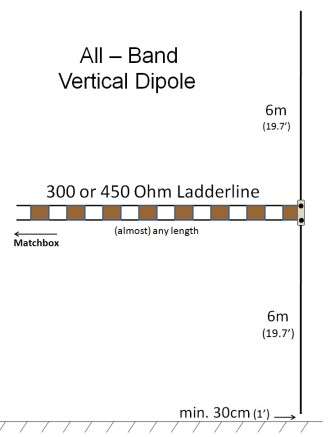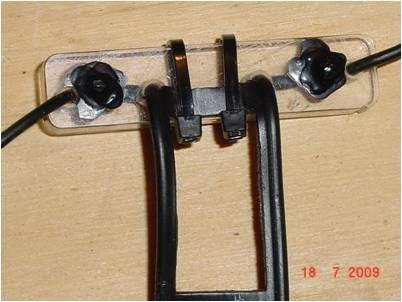AN ALL-BAND ANTENNA
FOR SMALL SPACES
Whether for portable, camping, or just for a small back yard, here is an antenna that is quick and easy to erect, and will get you on ALL bands from 80 through 10m.
THE VERTICAL DIPOLE
Note: The drawing shows 1 ft. elevation. That is the absolute minimum.
If possible, raise it 18 to 24 inches.
What is so special about this antenna?
- Low cost to construct
- Single lightweight pole required
- Ground-Independent (does NOT requires radials)
- Efficiency rivals a good vertical with 32 radials (except on 80m)
- With the right matchbox, it covers 80 through 10m
Details of a lightweight center insulator are shown at the very bottom of this page.
Who else recommends this antenna?
- This antenna is highly praised by L.B. Cebik, W4RNL (SK) in his paper entitled "A Vertical Doublet for 30-10 Meters.
- You can download L.B.'s paper here: http://www.cebik.com/
- (requires registering)
This is a GOOD ANTENNA, NOT A WONDER ANTENNA.
L.B. ran tests comparing this antenna to a trap ground plane mounted at the same height, with a good set of radials. His conclusion was that this antenna performs equally well to the ground plane, works more bands, and costs less. In his cost comparison he did not count the cost of a matchbox. His theory was, whereas you will wear out and replace antennas several time in your life, every ham has a matchbox anyway, and generally they last a lifetime.
What Matchbox is Best for this Antenna?
The short answer here is, if you have a matchbox already, by all means use it, even if you have to use an external balun.
If you do not yet have a matchbox and believe you will use openwire fed matchboxes a lot during your ham career, then there are some smart choices as well as some dumb ones.
I strongly recommend using a symmetrical matchbox for this task, rather than an asymmetrical matchbox with a balun.
Just because a manufacturer "claims" his product will match symmetrical antennas, that does not mean it is a symmetrical matchbox. In fact there are very few symmetrical matchboxes on the market.
For 100w:
- My top recommendation among matchboxes which are currently available new is the MFJ-974B symmetrical matchbox. This is the best low power "symmetrical" matchbox currently on the market. In fact I'm really not aware of any other symmetrical matchbox in the 100w class. That makes it the best by default, but it is very good.
- The best matchbox available on the used market in this class, particularly here in Germany is the Annecke "Symmetrische Koppler". These link coupled matchboxes are hard to find, but they are the very best - ever! Read L.B. Cebik's excellent article on Link Couplers or check out the Matchbox section on this web site for more info.
- I am well aware of the Johnson Viking 275w Matchbox. It is available on the used market in the states, but very rare outside of the US. BEWARE, unless you make the appropriate modifications such as implemented by Alfred Annecke in his line of Symmetrical Koppler matchboxes, you will probably be disapointed with your results. If you are still living in the dream world that believes the old Johnson was the best ever, it's time to go back to school. More on this subject under Matchboxes.
- Unfortunately we are almost out of choices. About 30 years ago in the UK, DECCA produced a low power and a high power symmetrical (link coupled) matchbox called the KW-EZmatch. These are still available on the used market here in Europe, especially in the UK. I still have one of these as "backup", but my MFJ-974B is better.
- If you were born rich and don't know where to spend your money, there is a German Company called "HamWare" that makes a fully automatic symmetrical matchbox. Be prepared to spend about $750 for a 200w matchbox. It is a great product but it's hard to justify spending that much money on a low power matchbox.
- BEWARE of misleading claims for matchboxes which are represented to be able to match symmetrical and asymmetrical antennas. MOST of these are asymmetrical matchboxes with a 4:1 current balun for connecting symmetrical antennas. Yes, they can indeed match the antennas, but a symmetrical matchbox is better. (BTW, do not be angry with the manufacturers for making these claims. They all do it and they couldn't sell their products if they didn't do it).
- If you do buy one of these asymmetrical matchboxes, I do have a recommendation, though it is a bit expensive: the Palstar AT-500. This is a differential-T matchbox which in theory is not better than a normal T-matchbox, but in practice, is better - because it is impossible to tune a differential-T to the wrong setting, and very easy to tune a normal T-matchbox to the wrong setting. This results in extensive losses in the matchbox.
FOR MORE MATCHBOX SUGGESTIONS, SEE: Low Power Symmetrical Matchboxes.
For High Power:
- The answer here is much more complex. There are numerous solutions available in Europe (4 or 5), but only a few in the US. They all have one thing in common. THEY ARE VERY VERY EXPENSIVE.
- I will write more on high power symmetrical matchboxes in the section on Matchboxes.
FOR MORE MATCHBOX SUGGESTIONS, SEE: High Power Symmetrical Matchboxes.
DETAILS OF CENTER INSULATOR:
This simple lightweight insulator is built of plexiglas.
Each side of the insulator has 3 holes.
On each side, one of the feedline wires and one of the radiator wires pass through the second hole (starting on the outside and counting inwards) and are soldered on the top, then trimmed and coated with liquid electrical tape.
Keep in mind that for this application (Vertical Dipole), there is really no stress on the individual wires of the dipole.
There is of course stress applied to the insulator by the openwire feedline, so you must forsee for strain relief. By running each feedline wire through two holes per side, you have fairly good strain relief. ADDITIONALLY, look carefully at the top of the feedline. Notice that there is a horizontal strip just where the wires enter the holes. Two ultra-violet resistant wire-ties help assure strain relief here.
Fasten the center of the dipole to the pole using 2 larger ultra-violet resistant wire-ties. Wrap each of these wire ties around the pole and insulator, passing between the outter two holes of the insulator.
I have created a set of exact instructions for building this insulator. You will find them in the OpenWire section, here: CENTER INSULATOR.



























